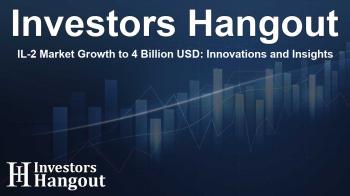IL-2 Market Growth to 4 Billion USD: Innovations and Insights

IL-2 Market Growth to Reach 4 Billion USD by 2034
As novel therapies continue to emerge, the United States IL-2 market is anticipated to reach a staggering USD 4 billion by 2034. This expansion is bolstered by numerous key players, including Iovance Biotherapeutics, Eisai, Citius Pharmaceuticals, Nektar Therapeutics, Mural Oncology, Corvus Pharmaceuticals, and Krystal Biotech.
Understanding IL-2 Therapeutics
Recent assessments indicate that approximately 13.6 million cases across several indications are treatment-eligible for IL-2 therapies. These indications encompass Peripheral T-cell lymphoma, Cutaneous T-cell lymphoma, Non-segmental Vitiligo, among others. Notably, the leading populations for IL-2 therapy development are those suffering from Non-segmental Vitiligo, Atopic Dermatitis, Alopecia Areata, and Non-small cell lung cancer.
Historical Significance of IL-2
The application of IL-2 in cancer treatment dates back to the early 1990s. Its ability to stimulate the immune system marked a significant leap in immuno-oncology. The first FDA-approved IL-2 therapy, PROLEUKIN (recombinant human IL-2), was introduced in 1992 for metastatic renal cell carcinoma, setting a new standard in cancer immunotherapy.
Scientific Advancements in IL-2 Therapies
IL-2 is not just limited to oncology; its potential extends into treating autoimmune diseases and inflammatory disorders. In a groundbreaking event, the FDA approved LYMPHIR for treating adult patients with relapsed or refractory Stage I-III Cutaneous T-cell Lymphoma. LYMPHIR exemplifies the next generation of IL-2 therapy, targeting immunosuppressive Tregs while also exerting antitumor effects on tumors expressing IL-2 receptors.
Latest Developments and Clinical Trials
Over the years, the IL-2 therapeutic landscape has evolved, seeing improved delivery methods and combination strategies designed to maximize effectiveness while minimizing side effects. Recent advancements include immune checkpoint inhibitors that work alongside IL-2 therapies, resulting in synergistic benefits for patients with previously untreated cancers.
Emerging IL-2 Therapies on the Horizon
Continuing research in the IL-2 space is crucial as therapies like Nemvaleukin Alfa are making their way through the pipeline. This targeted approach allows enhanced anti-tumor immunity with reduced toxicity typically associated with high-dose IL-2. Advancements also encompass a range of therapies, such as Rezpegaldesleukin, which is aimed at treating autoimmune diseases and is already showing promise in early clinical trials.
Market Trends and Projections
The projected growth of the IL-2 market reflects a significant transformation in the treatment landscape for both cancer and autoimmune diseases. By 2034, the market for IL-2-targeting therapies is expected to reach about USD 4 billion, highlighting IL-2's expanding role in medical innovation.
Strategic Insights for Stakeholders
Robust market analyses have detailed the key drivers behind this growth, informed by epidemiology forecasts, emerging drug market uptake, and historical insights that shape the current landscape. Stakeholders looking to navigate the IL-2 market are advised to consider the upcoming trends and new therapeutic avenues that promise to revolutionize treatment protocols.
Frequently Asked Questions
1. What is the significance of IL-2 in cancer treatment?
IL-2 plays a pivotal role in stimulating the immune system, enhancing the body’s ability to fight off cancer through targeted immunotherapies.
2. How has the landscape of IL-2 therapies evolved?
The landscape has evolved through advancements in precision medicine, combination therapies, and a focus on minimizing side effects while maximizing therapeutic benefit.
3. What are some emerging IL-2 therapies to watch?
Notable emerging therapies include Nemvaleukin Alfa and Rezpegaldesleukin, both of which are in advanced clinical trials and show promising results for cancer and autoimmune diseases.
4. Why is the IL-2 market projected to reach USD 4 billion?
The market growth is driven by increasing incidence of treatment-eligible cases, innovative drug formulations, and expanding applications across various therapeutic areas.
5. What are the implications of these developments for patients?
These advancements signify enhanced treatment options for patients, improved survival rates, and increased confidence in managing both cancer and autoimmune conditions.
About The Author
Contact Hannah Lewis privately here. Or send an email with ATTN: Hannah Lewis as the subject to contact@investorshangout.com.
About Investors Hangout
Investors Hangout is a leading online stock forum for financial discussion and learning, offering a wide range of free tools and resources. It draws in traders of all levels, who exchange market knowledge, investigate trading tactics, and keep an eye on industry developments in real time. Featuring financial articles, stock message boards, quotes, charts, company profiles, and live news updates. Through cooperative learning and a wealth of informational resources, it helps users from novices creating their first portfolios to experts honing their techniques. Join Investors Hangout today: https://investorshangout.com/
The content of this article is based on factual, publicly available information and does not represent legal, financial, or investment advice. Investors Hangout does not offer financial advice, and the author is not a licensed financial advisor. Consult a qualified advisor before making any financial or investment decisions based on this article. This article should not be considered advice to purchase, sell, or hold any securities or other investments. If any of the material provided here is inaccurate, please contact us for corrections.

